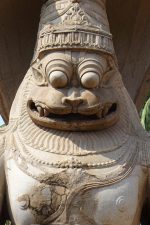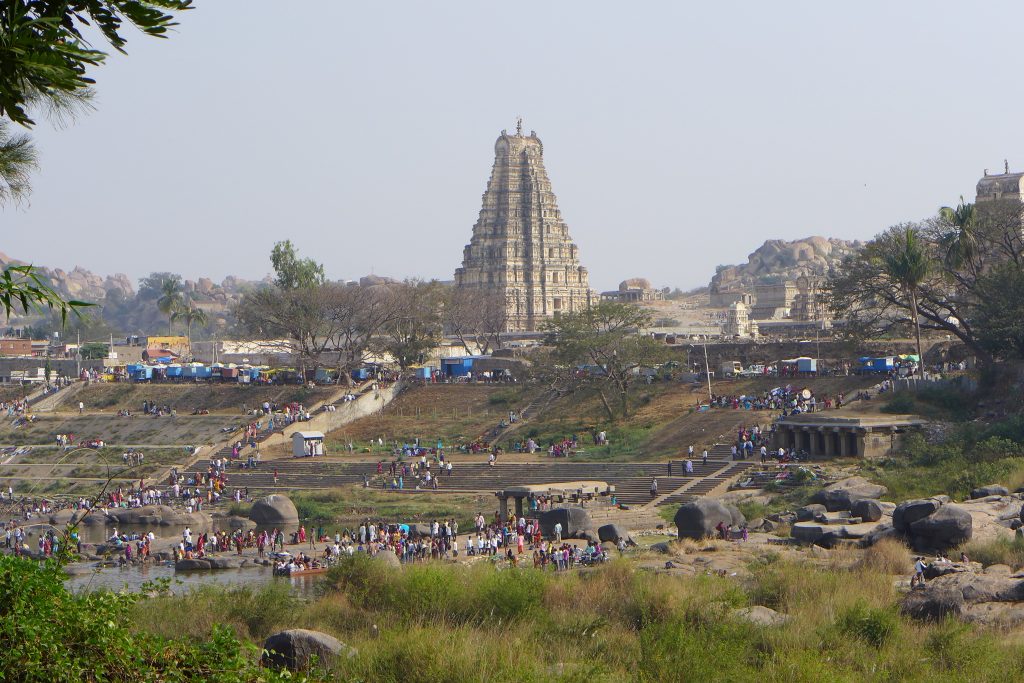
Happy Hampi – Our First Stop In Exotic Karnataka
Imagine the scene, we are sitting in a riverside café gazing down at the Tungabhadra River while the villagers and pilgrims gather at the banks to chat, wash themselves and their clothes and while their little boys scream and jump into the water. We are lucky to have arrived just in time for Pongal (the Harvest festival) where thousands of pilgrims congregate to make offerings to the Gods (we were told this is primarily celebrated in the South of India.)
In the background you can see Virupaksha temple, the only temple in Hampi still used for worship, as well as multiple other ruins in the surrounding area. Hampi is reminiscent of Angkor Wat in Cambodia – though much smaller in size the architecture is very similar. Instead of seeing the spires through the jungle as in Cambodia, here one sees them peering up through the massive boulders.

Hampi was the capital of the biggest Hindu Empire that has ever existed. It was the capital of the Vijayanagara Empire during the 15th and 16th centuries and was a major trade center with traders coming from Arabia, Portugal, China and Italy to trade and was also a significant spiritual center. There was so much wealth here that the gold and diamonds were sold by the kilo not by the ounce and in the evening when the markets closed they were simply covered with a cloth (not locked up) until the next day of trading. At its height, the population reached 500,000 people not including a massive army of over 2 million soldiers, this made Hampi the 2nd largest city of the time, right after Beijing. In 1565 the Deccan Sultanates defeated the Vijayanagara Empire and upon entering Hampi triumphantly, proceeded to destroy most of their temples and icons.
It is believed if the statues are damaged or disrespected in any way that the Gods will leave the statues and they will no longer be considered holy but simply monuments. Amongst these amazing statues is Ganesha, the elephant god, a 4 ½ meter tall monolith that we estimate must weigh at least 40 tons. It is the largest statue of Ganesha in existence and it is incredible. Though part of its trunk and belly were damaged by the invaders, it is still an impressive site to see. His hands alone are 4 times the size of my head. He is called ‘Peanut’ because it was the peanut sellers who paid for his creation (400 years ago)…. Can you imagine how many peanuts they had to sell? Now that is devotion!
We arrived in Hampi, in the state of Karnataka, after a 12 hour overnight bus ride, as we continue our voyage south (and west) through India. Are you wondering how the bus journey was? It was our first sleeper bus so were curious about the set up – it has rows of single bunks (in bunk bed format) on the left side of the bus and on the right side they have the double sleepers (also double decker) with some seats replacing the first 2 sets of bottom bunks. We were unfortunately stuck in the seats as they were sold out of sleepers… that’s ok …. It’s about the journey, right?!

We decided not to stay in Hampi town (a tiny settlement of 1500 people) and cross the river to stay at Virupapur Gaddi which we heard was a little bit mellower. We crossed the tiny river in a rusty old pontoon boat – the fare is supposed to be 10 rupee but since it was early and we were all foreign backpackers the driver decided the fare should be 50 rupees. Though there was a lot of grumbling in the boat as we set off on the 2 minute ride across the river. We checked into our bungalow at Sunny’s place with views over the rice fields and the boulders and under the shade of some coconut and teak trees. Paradise.

In the morning we walked down to the river where, according to our guide book, the temple elephant named Lakshmi would be bathed by her mahout (elephant keeper.) We saw her descending the ghats toward the river with the villagers looking on with joy. She was thoroughly scrubbed by 3 men who seemed to use a type of brillo brush to do the job while Lakshmi laid in the river. We were lucky enough to visit her temple soon after her bath when she offers blessings to the people. You can offer her bananas or a monetary offering and she lays her trunk over the top of your head and blesses you. It was really a magical experience.

Feeling blessed we decided to explore on foot a bit and walked across the ruins of the massive Hampi market. At the other end we decided to climb the steep granite steps to get to Veerabhadra Temple, on Matanga Hill, to get a birds eye view of the area. It was well worth the climb! Between panting to catch my breath under the midday sun, all I could imagine was how difficult it must have been to build the granite steps leading up to the top (these date from the time of the Empire). It is fascinating to imagine how many thousands of other people have walked these steps before me in the past six hundred years. At the end of our exploration, we followed the crowds and found a way to cross the river on foot, thus outsmarting the “ferry” driver for the day.
Since the ruins are spread out over 25 square miles and contain over 3700 monuments, we decided to join a bike tour the next day with a guide to explore some of the outer ruins. The bikes were not in the best shape (imagine wobbling wheels and no gears) but they did the trick and off we went. Some of these sites were only discovered in 1984 so are relatively new and more ruins are still being found today. While riding around you could imagine how impressive this empire must once have been. The main complex where the King had an audience hall, was once made principally of sandalwood, today only the holes in the granite show where the pillars stood, when the Sultans conquered they burned the complex for 6 straight months to ensure it was entirely destroyed.
On Pongal (the Harvest festival), we rented a mini scooter (to be honest, it was more like a lawnmower with wheels and a daffy duck horn) to explore the area a bit and check out where Hanuman was born. We got up pretty early and headed to Hanuman temple, after a climb of 575 steps we reached the top. As we were enjoying the view we were again discovered by the locals (we call them our paparazzi) and had to pose for endless photos. Here’s Kevin taking a round of ‘selfie’s.

We received our blessing from the priest and after some more viewing (and more photos with the fans) we headed back down. We were glad to have arrived early as when we drove by later the steps were at a standstill, there were so many people trying to go up to worship a bottleneck had formed. We spent the rest of the day exploring the local countryside as people giggled and waved as we drove by. Besides the festival traffic, the area is very laid back and relaxed so it was a pleasure to drive around and enjoy the scenery. Later as we walked around Hampi Bazaar we saw some curious characters – one Sadhu (holy man) with a bone pierced through his cheek begging for alms and a snake charmer sitting near the temple – one could say he was busking with his snake.

In the evenings, we would climb to the top of the boulders near our guest house to enjoy sunset. The panoramic views in addition to the drum (and other instrument) circle creates a magical atmosphere up there. You can see the ruins of Hampi as well as the many banana and rice plantations around the site which create an impressive contrast of humongous rose colored granite boulders lying between the lush green of the bananas and rice. Once night had fallen, we would sit on our patio and listen as the frogs started their nightly songs and watch as the moon rose over the mountains reflecting in the rice paddies.

Hampi is another great spot in India that I would recommend to anyone. Tonight we have our 2nd overnight bus and we are heading to the beaches of Gokarna as our adventure continues. Don’t worry – we reserved early and got the sleeper this time.
P.S. Though we reserved early it turned out our seat was double booked … nothing is ever easy in India….